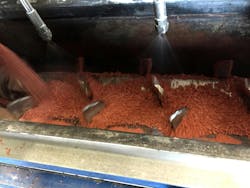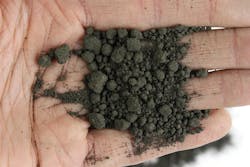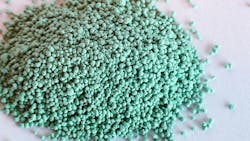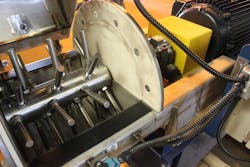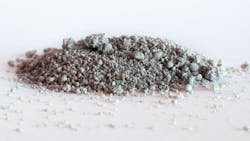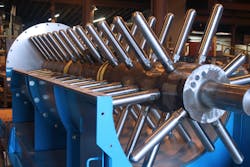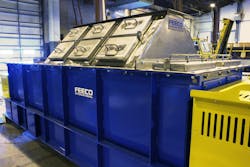Maximizing mixer potential through testing
Industrial process mixers such as pin and pugmill mixers play an essential role throughout the industrial space, whether processing minerals, concentrates, pigments, chemical products, or anything in between.
While most people think of mixers as solely used to combine separate feedstocks, the capabilities of industrial mixers go far beyond that, with the potential to accomplish a number of critical process objectives and even yield small agglomerates or granules.
The diverse capabilities and opportunity for customization these mixers offer means that meeting the unique objectives of a given application, whether new or well-established, often requires some level of testing at a minimum.
The following information highlights the importance of such testing, what the testing process looks like, and the information gained when developing pin and pugmill mixers. While some information may be specific to testing in the FEECO Innovation Center and these two types of industrial process mixers, the principles extend beyond both facility and mixer type.
What a mixer can do for your process
Mixers can be used as a standalone device to create a finished product, or they can be added to the front end of a process to create a more uniform feedstock for improved production. The flexibility of process mixers lends them to a wide range of processes dealing with bulk solids. They are commonly used in the following settings:
Mixing. Mixing precursors or recycle for a larger agglomeration process, such as a pelletizing or briquetting line, as well as mixing to produce a final or intermediary material.
Conditioning. Dedusting materials for transport to landfill or generally making dusty materials easier to handle, transport, or utilize in downstream processes. Examples include dedusting fly ash, cement kiln dust, and more.
Agglomerating/granulating. Producing rough granules or uniform micro pellets such as can be found in the soil amendment and fertilizer industries, carbon black processing, and more.
Why process development testing is important
Whether a mixer will be used in a larger process or as a standalone device, the importance of process development testing cannot be overstated. While some may consider it a luxury or an unnecessary expense, process development work provides essential opportunities by confirming feasibility, reducing scale-up risks, and streamlining the path to commercialization.
This type of testing answers critical questions, such as:
- Which mixer type is best suited for a given application?
- Can the intended mixer achieve the desired goal?
- Can the mixer reach target specifications such as particle size distribution, density, etc.?
- What kind of throughput can be achieved while still meeting the product goals?
- Can the process be stable on a continuous scale at the desired throughput?
- What challenges will the source material present and how can these be addressed through design modifications or customizations?
- What binder, if any, will best serve the process?
- Will material buildup be an issue?
- How much power consumption can be expected from the process?
Testing also helps processors gain familiarity with their specific source materials and how they will respond to the intended treatment.
Material variation
Variation across material derivatives and even the same material from different sources also mandates test work. Even with well-established processes, the specific qualities of the unique source material can require testing to work out the process variables necessary to yield product according to the desired specification.
Testing for existing processes
It is important to understand that process development testing is not restricted to new processes. Testing in a facility that can simulate production conditions is also a vital tool in assessing changes to an existing production line, troubleshooting issues in a non-production environment, and evaluating potential ways to improve upon an existing process or product.
No matter the objective, testing greatly reduces scale-up risks, whether through confirming the feasibility of an intended process, identifying and addressing issues prior to capital investment, or establishing the parameters necessary for a commercial production setting.
What the testing process looks like
The scope of process development testing can vary significantly depending on the testing objectives, as well as on what is already known about the process and source material. In general, however, when developing a new process, testing typically begins at batch scale and progresses toward continuous pilot-scale testing with each success. This process is summarized as follows.
Proof of concept (Feasibility testing)
Feasibility testing is conducted at batch scale and focuses on answering the most pressing questions — most importantly, if the intended process is physically feasible and if it can likely be achieved using the chosen mixer type. This stage of testing can also uncover potential roadblocks the operation could run into.
Ultimately, this testing confirms or denies feasibility and informs whether additional investigation is merited. As such, only a minimal amount of material is required for testing at this stage.
Proof of product
Also conducted at batch scale, proof of product takes the testing process a step further, investigating on a deeper level if the product can be produced to the desired specifications and be economically viable.
This step also helps to narrow down the range within which high-level variables, such as feedstock moisture content, particle size distribution, binder spray rate, and more, will need to fall to achieve the desired result. This step establishes basic process criteria, setting the stage for continuous, pilot-scale testing.
Proof of process
Once proof of product has been confirmed, testing moves on to illustrating proof of process. Again, this stage of testing builds off data gathered in the previous step and aims to confirm that the process is viable on a continuous scale.
During this stage, process experts work to establish the process and material conditions necessary to achieve a stable process that can reliably and consistently yield product to specification on a continuous basis.
Process/product optimization
While the former step focuses on identifying the basic criteria necessary to continuously yield on-spec product, process/product optimization works to refine that process. As with each previous stage, this optimization work builds on the data gathered in the previous stages.
Here, process experts fine tune variables for optimal product quality, yield, and production efficiency. This is the final stage before commercialization, and it provides a pilot-scale production model engineers can use for plant layout and equipment engineering. From this data, engineers can establish several deliverables critical to realizing the project:
- Process & Instrumentation Diagrams (P&IDs)
- General Arrangement Drawings (GADs)
- Conceptual Plant Layouts
- Civil Works Guide Drawings with Static & Dynamic Loads
- Structural Steel and Access Platform Guide Drawings
- Chute and Ductwork Guide Drawings
- Material Handling Engineering
Variables that affect the mixing process
Throughout testing, process experts work with a variety of process and material variables to establish the most effective approach. These include:
- Feed rate
- Binder spray rate
- Spray location(s) along length of mixer
- Spray height above material bed
- Nozzle type(s)
- Binder temperature and pressure
- Particle size distribution
- Feedstock moisture content
- Retention time
- Capacity
- Pin/paddle arrangement
- Shaft speed
- Recycle ratio (where applicable)
By modifying and fine tuning these parameters, experts can home in on the requirements needed to achieve various target particle characteristics, such as:
- Bulk density
- Moisture content
- Attrition
- Particle size distribution (PSD)
- Crush strength
- Green strength
- Flowability
- And more
Samples can also be generated for testing trials.
Additional data gathered through testing
In addition to establishing key process criteria, testing also reveals a plethora of other important information as well. For example, testing may uncover the need for material pretreatment such as drying or grinding in order to bring the feedstock into the most suitable range for the desired objective.
Testing also frequently identifies potential production issues best addressed through equipment design. Issues such as chute plugging or a material’s tendency to harden and set in the mixer if not moving may yield the need for modifications such as alternative materials of construction, trough liners, pin or paddle coatings/facings, or otherwise.
Similarly, the presence of an exothermic reaction may elicit the need for thermocouples, heat sensors, or potentially more advanced process control capabilities.
Testing may also identify the need for regular cleaning, making additions such as inspection doors, raising cover assemblies, drop-out bottoms, etc., useful in minimizing downtime associated with cleaning and maintenance.
When mixing will be incorporated with an additional agglomerator or drying equipment, continuous testing offers a particularly valuable advantage, showing how material will move through the production line at various stages. This also allows the producer to gather data on other essential aspects of the process, such as drying, screening, and recycle, if applicable. Moreover, it helps to predict handling behavior at various points, which is useful in designing conveyors, bucket elevators, and other bulk solids handling equipment the plant will require.
Conclusion
Industrial process mixers have become an essential tool in processing a wide range of bulk solids, homogeneously blending solid and liquid feed components for seamless processing and greater end-product uniformity. From simple mixing to agglomeration applications, mixers have become a critical component in allowing processors to efficiently manufacture products to specification.
Their diverse capabilities, paired with their extensive opportunity for customization, make process development testing vital to developing an effective process optimized for efficiency, as well as optimizing an existing process without affecting the live production environment.
Chris Kozicki is a process sales engineer at FEECO International.
FEECO International
www.feeco.com
About the Author
Chris Kozicki
Process Sales Engineer at FEECO
Chris Kozicki is a Process Sales Engineer specializing in tumble-growth agglomeration and has been with FEECO for over 30 years. Chris is an active member of the agglomeration community and former president of the Institute for Briquetting and Agglomeration (IBA).
